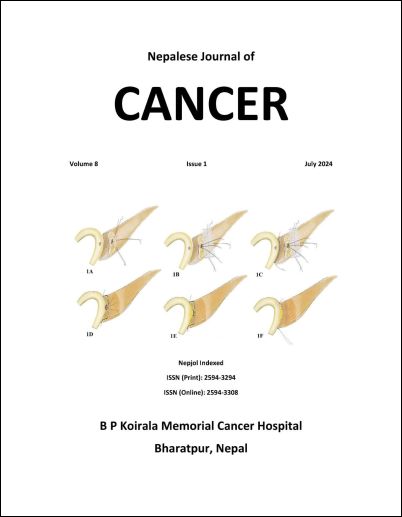Postoperative Complications of Radical Cystectomy and Urinary Diversion using Clavein-Dindo Classification in Tertiary Care Hospital
DOI:
https://doi.org/10.3126/njc.v8i1.68235Keywords:
Cystectomy, Comorbidity, Postoperative complication, Urinary bladder cancerAbstract
Background: The gold standard treatment for muscle-invasive transitional cell carcinoma of the bladder is radical cystectomy (RC) with urine diversion. The mortality and morbidity rates ranged from 0 to 9.0% and 30 to 70%, respectively in various reports. Among various classifications of complications, the Clavien–Dindo classification (CDC) is applicable to most procedures for comprehensive surgical outcome assessment. The study will be helpful to identify the potential early postoperative complications and possibly minimize the morbidity and mortality of this surgery in the future.
Materials and Methods: Prospective study of 60 patients with Bladder Cancer fulfilling the inclusion criteria who underwent radical cystectomy with urinary diversion was collected from January 2023 to June 2024 at B.P. Koirala Memorial Cancer Hospital. The various demographic data and perioperative parameters were recorded. The early complications defined as the complications during hospitalization or within 30 days of surgery were enlisted and then classified according to Clavein-Dindo Classification. Data were analyzed using SPSS 25 software.
Results: Many patients, 56 (93.33%) patients had some form of postoperative complications of radical cystectomy with urinary diversion. Of these, GI complications were (41.7%), infections related (21.7%), Wound related (11.7%) and others. 23 (38.33%) patients had high grade (≥ Grade III) complications. The mortality rate was 6.7%.
Conclusion: Radical cystectomy is complicated surgery involving at least 2 systems in the body ie genitourinary and Gastrointestinal systems. So it is associated with higher rate of morbidity.
Downloads
Downloads
Published
How to Cite
Issue
Section
License
Copyright (c) 2024 Nepalese Journal of Cancer

This work is licensed under a Creative Commons Attribution 4.0 International License.
This license lets others distribute, remix, tweak, and build upon your work, even commercially, as long as NJC and the authors are acknowledged.
Submission of the manuscript means that the authors agree to assign exclusive copyright to NJC. The aim of NJC is to increase the visibility and ease of use of open access scientific and scholarly articles thereby promoting their increased usage and impact.




